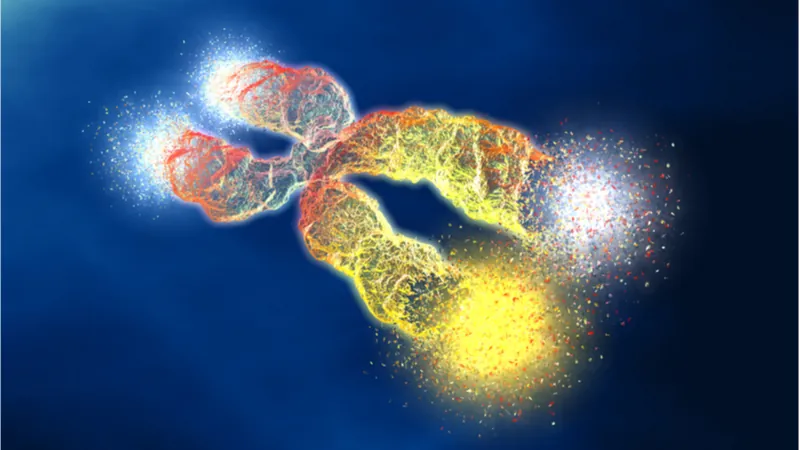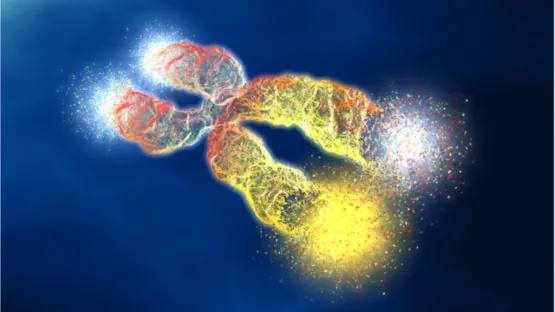Scientists have discovered a new telomere-protecting mechanism in embryonic stem cells. This discovery can bring us closer to solving the notorious problem of telomere attrition and to understanding the immortality of cancer cells [1].

Read More
Keeping telomeres in the loop
One function of telomeres is to prevent the ends of chromosomes from fusing with foreign molecules or with each other. A protein complex called shelterin achieves this, in part, by tying a knot called a T-loop at the end of a telomere and essentially hiding the vulnerable extremity. One subunit of shelterin responsible for forming the T-loop is TRF2. The depletion of this protein has resulted in end-to-end chromosome fusions in all cell types tested so far. However, the authors of this new study have discovered that this does not happen in mouse embryonic stem cells (ES cells). Understanding the mechanism behind this resilience might help us in our fight against aging.
TRF2 is a highly evolutionary conserved protein, and its essential nature have been confirmed across more than 700 cell lines of various types, all of them somatic. The researchers decided to see for the first time how TRF2 depletion, which usually leads to cellular and organismal death, plays out in ES cells. Upon the deletion of the TRF2-producing gene, the control group of differentiated cells (derived from the same ES cells), as expected, showed numerous chromosome end-to-end fusions, which resulted in cellular death. On the contrary, TRF2-knockout ES cells continued to proliferate.
Unprotected chromosome ends are perceived by cells as DNA breaks. This triggers the DNA damage response (DDR), a cascade of actions that try to stitch chromosomes together. DDR is lifesaving when a DNA break occurs in the middle of a chromosome, but by joining the ends of chromosomes together, it creates a mess and triggers senescence. However, TRF2-KO ES cells showed very muted DDR. To understand what prevented full-fledged DDR in the ES cells, the researchers performed transcriptional profiling of the ES cells and of the differentiated control cells.
Lengthening instead of fusing
Zscan4, a six-gene cluster, was found to be among the most-upregulated genes in TRF2-KO ES cells. Zscan4 is essential in ES cells and is known to promote telomere lengthening and genomic stability. What was previously unknown, though, is that Zscan4 apparently rescues ES cells in the absence of TRF2. By contrast, TRF2 depletion in the differentiated control cells did not result in increased expression of Zscan4, making this feature exclusive to stem cells. Artificial downregulation of Zscan4 expression in TRF2-KO ES cells resulted in telomere fusions, confirming the telomere-saving role of the gene cluster. Moreover, upregulated Zscan4 appeared to replace deadly chromosome fusing with beneficial telomere lengthening.
Finally, the researchers tested whether overexpression of Zscan4 in differentiated cells could similarly mitigate telomere dysfunction induced by TRF2 deletion, which it did by a respectable margin of 50%. It shows that the discovered mechanism, theoretically, can be used for telomere stabilization and elongation in differentiated (somatic) cells.
We propose that in ES cells that express Zscan4, TRF2-depleted telomeres are elongated rather than being processed as sites of DNA damage. Given that specific cancer cells can adapt to high levels of telomere dysfunction, it is possible that mechanisms analogous to the ones we uncovered here in ES cells might be hijacked in pathological conditions.
Conclusion
This interesting research elucidates some new aspects of telomere behavior in embryonic cells and differentiated cells. Although the authors do not suggest an immediate practical implementation for their discovery, telomere attrition is a hard-to-solve and important problem, which makes any new piece of knowledge about it extremely valuable.
Literature
[1] Markiewicz-Potoczny, M., Lobanova, A., Loeb, A. M., Kirak, O., Olbrich, T., Ruiz, S., & Denchi, E. L. (2020). TRF2-mediated telomere protection is dispensable in pluripotent stem cells. Nature, 1-6.



